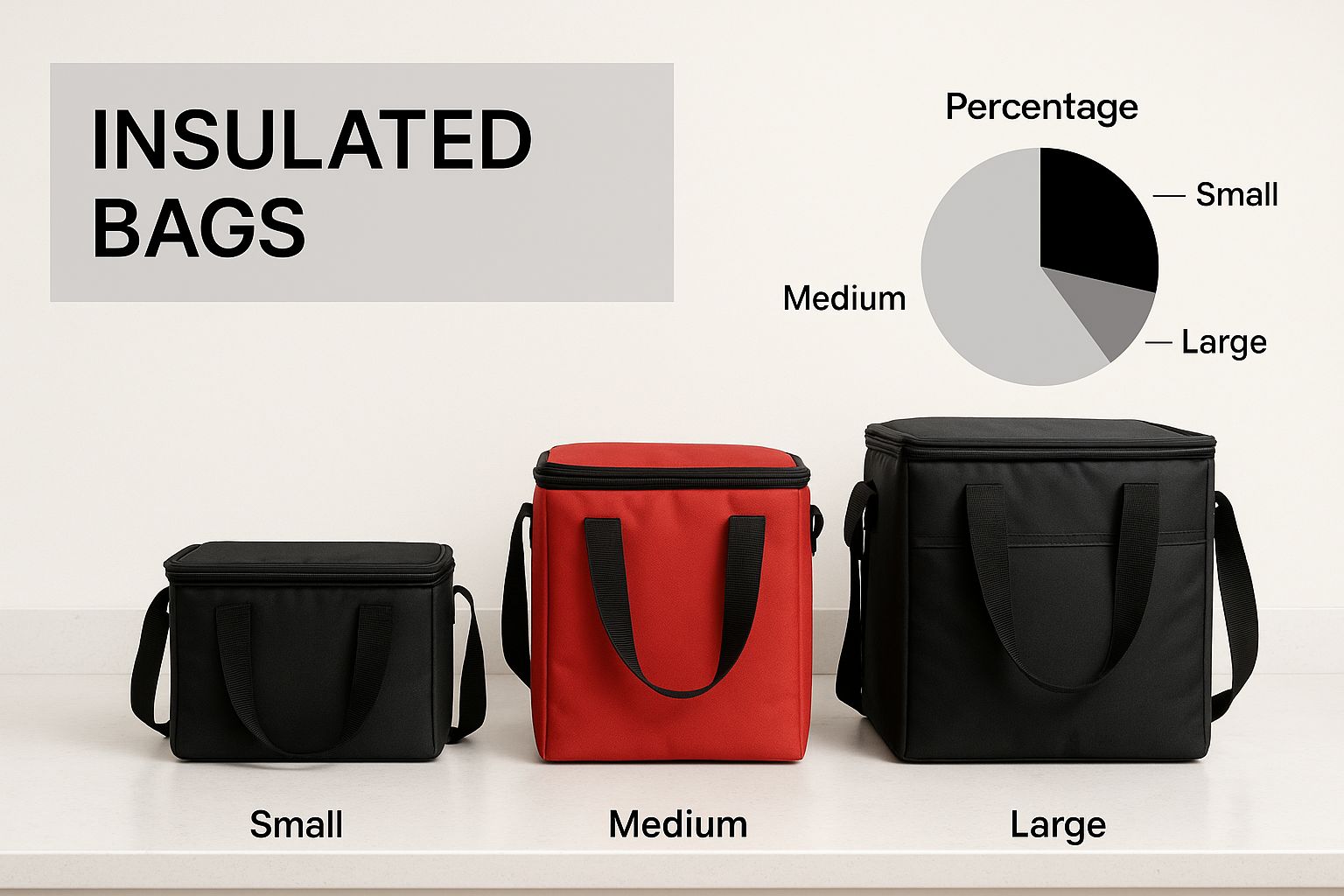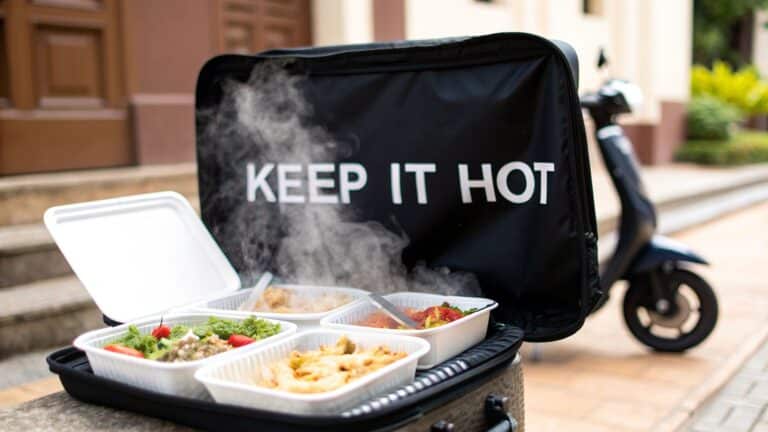Why Food Temperature Makes or Breaks Your Delivery Business
Knowing how to keep food hot for delivery is paramount. It’s not just about taste; it’s about customer satisfaction and the overall success of your business. A lukewarm burger or cold fries can quickly sour a positive experience, leading to disappointed customers and negative online reviews. This directly impacts your bottom line and brand reputation.
Customer satisfaction is essential for a thriving delivery operation. Failing to deliver food at the correct temperature can lead to negative reviews and a decline in repeat business. This, in turn, can affect your restaurant’s overall profitability.
The Science Behind Safe Food Temperatures
Maintaining correct food temperature isn’t just about customer preference; it’s a critical food safety issue. The “danger zone” for food is between 40°F (4°C) and 140°F (60°C). In this temperature range, bacteria multiply rapidly, increasing the risk of foodborne illness. The longer food stays in this zone, the greater the risk.
Keeping hot food above 140°F (60°C) is essential. This protects your customers’ health and maintains your reputation for safe, high-quality meals. Proper temperature control before delivery is equally important. Insulated equipment and efficient delivery logistics are crucial for preventing temperature drops during transit.
The Impact of Temperature on Customer Loyalty
Temperature significantly impacts the sensory experience of food. A perfectly cooked steak loses its appeal when cold, and melted ice cream becomes an unappetizing mess. These negative experiences can lead to refunds and erode customer trust, making future orders less likely.
Consistently delivering hot, delicious food creates loyal customers. These satisfied customers appreciate the quality and reliability of your service. They become advocates for your brand, generating positive word-of-mouth and driving repeat business. This results in increased order frequency and a stronger bottom line.
The demand for effective temperature control solutions is on the rise. The global food holding and warming equipment market was valued at US$4.7 billion in 2022. It is projected to reach US$6.7 billion by 2033.

Mastering food temperature control for delivery is not just a logistical hurdle; it’s a strategic imperative. It directly impacts customer satisfaction, brand reputation, and ultimately, your business’s success. Prioritizing temperature control is an investment in a positive customer experience and fosters long-term growth.
Game-Changing Equipment That Keeps Food Sizzling Hot
Knowing how to keep food hot for delivery is essential for any business looking to impress customers. Simply using insulated bags isn’t enough anymore. To truly elevate the delivery experience, restaurants need to understand the limitations of standard equipment and explore innovative solutions designed for superior heat retention.
Beyond the Insulated Bag: Exploring Advanced Options
Standard insulated bags offer a basic level of temperature control, but they struggle over longer distances and delivery times. For these situations, premium insulated bags, often made with thicker insulation and advanced materials, are a better choice. While the initial cost is higher, these bags offer significantly better heat retention, ensuring your food arrives piping hot. It’s like the difference between a light sweater and a heavy winter coat.
Actively heated delivery bags are another game-changer. These battery-powered wonders maintain consistent temperatures throughout the delivery process. Even delicate dishes arrive at the ideal serving temperature, regardless of the weather outside. Imagine delivering a perfectly cooked steak; with a heated delivery bag, it arrives just as juicy and tender as when it left the kitchen.
The Rise of Electric Heating Solutions
Electric heating solutions are transforming how we deliver hot food. Portable food warmers, commonly used by caterers, are now being adapted for delivery. These warmers, which plug into a vehicle’s power outlet, maintain restaurant-quality temperatures for extended periods. This is particularly useful for businesses with longer delivery routes or those specializing in temperature-sensitive dishes.
Some innovative ghost kitchens are even investing in commercial holding equipment, the kind typically found in restaurants. These high-tech units keep food at precise temperatures for hours, allowing businesses to expand their delivery radius and reach new customers. In 2019, warming equipment held 30% of the commercial food warming and holding market, while holding equipment represented 34%. Innovations like Unox’s hot refrigerator highlight the growing focus on energy-efficient technology.
These investments minimize food waste and operational costs, which become increasingly important as delivery volumes rise. This trend demonstrates a global reliance on precise warming tools to meet both food safety regulations and growing consumer expectations.
Choosing the Right Equipment for Your Needs
Choosing the right equipment depends on several factors: the type of food you deliver, your delivery distance, and your budget. The data chart below compares different insulation options, highlighting their temperature retention capabilities over time.
The following data chart visualizes the temperature retention of various food delivery insulation options over specified durations.

As the chart shows, actively heated bags consistently maintain high temperatures. Premium insulated bags perform better than standard bags, but their effectiveness gradually decreases. While holding cabinets excel at temperature maintenance, their size and power requirements make them less practical for individual deliveries.
To help illustrate the differences between various food delivery insulation options, we’ve compiled them into this table:
Comparison of Food Delivery Insulation Options
| Equipment Type | Temperature Retention (minutes) | Cost Range | Best For | Limitations |
|---|---|---|---|---|
| Standard Insulated Bag | Up to 30 | Low | Short distances, quick deliveries | Limited temperature control over longer periods |
| Premium Insulated Bag | Up to 60 | Medium | Medium distances, moderate delivery times | Temperature gradually declines |
| Actively Heated Bag | Consistent, up to 120+ | High | Long distances, temperature-sensitive items | Requires battery power |
| Holding Cabinet | Consistent, extended periods | Very High | Catering, large orders, extended holding times | Bulky, requires a power source |
In conclusion, while standard insulated bags might work for short deliveries, premium or actively heated bags are necessary for maintaining temperature over longer periods. Selecting the right equipment can significantly improve the quality of your delivered food, directly impacting customer satisfaction and, ultimately, your bottom line.
Packaging Secrets From Top-Performing Delivery Kitchens
Maintaining the right food temperature during delivery is about more than just insulated bags and speedy drivers. It’s about understanding the nuances of food packaging. High-volume delivery kitchens have mastered this art, keeping food hot and delicious upon arrival. By learning from their strategies, you can significantly improve your own delivery game.
Strategic Layering: Preventing Temperature Transfer
One common delivery mistake is packing hot and cold items together. This creates a temperature imbalance, with hot food losing heat to cold items. High-performing kitchens avoid this through strategic layering, separating hot and cold items with thermal barriers. For example, placing a salad next to hot fries leads to soggy disappointment. Instead, use a divider or separate bags.
This principle also applies to dishes with varying temperatures within a single meal. Separating components within the packaging makes a big difference. This helps maintain individual temperatures, ensuring each item arrives in optimal condition.
Venting: The Balance Between Heat and Texture
Proper venting isn’t just about preventing sogginess; it’s also a temperature control tool. Trapped steam causes condensation, lowering food temperature and affecting texture. High-performing kitchens use vented containers strategically, releasing excess moisture. This keeps crispy food crisp and prevents temperature-sapping condensation.
However, too much venting can lead to heat loss. The key is balance. A small vent or perforated lid can often release steam without compromising heat retention. This maintains optimal temperature while preserving the desired food texture.
Thermal Barriers: Maximizing Heat Retention
Creating thermal barriers within the packaging is a cost-effective and powerful technique. Simple materials like aluminum foil and parchment paper trap heat and slow cooling. Wrapping hot items in foil adds insulation, preventing heat escape. This is especially useful for sandwiches and wraps.
Lining insulated bags with foil further enhances heat retention. This creates a reflective surface, bouncing heat back towards the food. These simple techniques significantly extend the time food stays hot.
Container Selection: Choosing Wisely for Optimal Results
Different foods require different packaging. High-performing kitchens understand this, using a variety of containers tailored to specific food types. Insulated containers are essential for soups and stews, maintaining temperature and preventing spills. Vented containers are designed for fried foods, preserving crispness while allowing steam to escape.
Careful container selection also considers portion size. Overfilling containers can cause uneven heating and temperature fluctuations. Choosing the right size ensures even heating and consistent temperature during transport. These nuanced strategies significantly impact the customer’s sensory experience.

Delivery Logistics That Keep Food Hotter, Longer
Mastering how to keep food hot for delivery goes beyond simply using good packaging. Efficient delivery logistics are crucial. Even the best-insulated containers won’t perform if the delivery process is poorly managed. Restaurants must optimize their entire delivery operation, from order placement to handoff, with temperature as a top priority.
Determining a Realistic Delivery Radius
Many restaurants overestimate their delivery range. This leads to long delivery times and, as a result, cold food. Successful restaurants, however, determine their delivery radius based on temperature tests, not just distance. This guarantees that all deliveries, no matter the location, meet the necessary temperature standards. For example, a restaurant might discover that their packaging keeps food at the right temperature for a 30-minute delivery radius, but not 45 minutes.
This data-driven approach allows restaurants to adjust packaging or delivery methods for customers farther away. By taking these steps, businesses can expand their reach while maintaining high food quality for every delivery.
Leveraging Route Optimization Technology
Route optimization software is increasingly common in the delivery industry. Many restaurants use it for speed and efficiency. Leading delivery operations, however, are using route optimization to prioritize temperature preservation as well. This means drivers are guided along routes that minimize delivery time for temperature-sensitive items, even if it’s not the fastest route overall.
For example, an order with hot soup might be prioritized over a less temperature-sensitive order to ensure the soup arrives hot. This strategic approach balances efficiency with food quality, reducing temperature-related complaints. The importance of such solutions is highlighted by heat-driven delivery surges. A 2025 study revealed Chinese residents avoided 3.6 annual heat-exposure hours by using delivery during extreme heat, but 45% of that risk shifted to couriers.
Delivery riders in Shanghai and Hangzhou worked 6% longer in heatwaves, emphasizing the need for equipment that withstands prolonged use. With the Asia-Pacific market growing rapidly (3.0% CAGR), efficient warming technology becomes even more crucial. Platforms are increasingly bundling orders, requiring devices that maintain temperatures of 140°F (60°C) and above across multiple delivery stops.
Streamlining Handoff Procedures
The handoff between the restaurant and the driver is a crucial moment for temperature control. Long wait times at the restaurant significantly impact food temperature, regardless of packaging. High-performing kitchens have streamlined their handoff protocols to minimize these delays. This typically involves designated driver pickup areas, clear communication systems, and real-time order tracking.
Some restaurants use heated shelves or holding cabinets in these designated areas. This keeps food hot until the moment of handoff. This focus on efficient handoff ensures that the efforts in the kitchen and during packaging aren’t wasted in the final delivery stages.
Engineering Your Menu for Temperature Success
The secret to delivering piping hot food often lies in something easily overlooked: the menu itself. Smart restaurants design their menus with temperature in mind. They carefully consider which ingredients retain heat best, tweak their cooking methods, and even rethink presentation to guarantee a delicious, hot meal arrives at your customer’s door.
Ingredient Selection: Choosing Foods That Hold Heat
When it comes to heat retention, not all ingredients are equal. Dense proteins like steak and chicken naturally hold heat better than lighter options like fish or vegetables. Choosing the right ingredients is the first step towards temperature success. A hearty beef stew, for example, will stay warmer longer than a delicate pasta dish.
This doesn’t mean your menu has to be limited to heavier dishes, though. Combining ingredients strategically and using clever preparation techniques can dramatically improve the temperature performance of even lighter meals.
Modifying Cooking Techniques for Delivery
Traditional cooking methods often need adjustments for delivery. Strategic finishing temperatures are crucial. Cooking dishes slightly longer, within safe food handling guidelines, ensures they retain enough heat to arrive at the ideal temperature. This is especially important for items that cool down quickly.
Another helpful technique involves controlled undercooked elements, particularly for dishes that continue cooking in transit. For instance, pasta can be slightly undercooked, knowing it will finish cooking in the hot sauce during delivery, preserving its texture and ensuring a perfect temperature upon arrival.
Sauce Application, Layering, and Garnish Timing
How you apply sauces and layer ingredients significantly impacts temperature. Sauces act as insulators, trapping heat and slowing the cooling process. Distributing sauce evenly across a dish, instead of just on top, maximizes its insulating effect. Similarly, strategic layering can create pockets of heat within the dish.
Garnish timing matters, too. Adding delicate garnishes right before delivery, instead of at the restaurant, prevents them from wilting or getting soggy during transit, preserving the dish’s visual appeal and textures.
To better illustrate how to choose and package different food types for delivery, let’s look at this table:
Food Types and Their Temperature Retention Properties
| Food Category | Natural Heat Retention | Cooling Time | Recommended Packaging | Special Considerations |
|---|---|---|---|---|
| Fried Foods | Moderate | Fast | Vented Containers | Thicker batter for delivery |
| Soups/Stews | High | Slow | Insulated Containers | Transport in separate bags |
| Pasta Dishes | Moderate | Moderate | Tightly Sealed Containers | Slightly undercook the pasta |
| Grilled Meats | Moderate | Moderate | Foil Wrapping | Rest the meat before packaging |
As you can see, different food types require different approaches to packaging and preparation to best maintain ideal temperatures during delivery.
Menu Modification Strategies for Existing Restaurants
If your restaurant is struggling with delivery temperature, modifying existing menu items can be a game-changer. This might involve creating delivery-specific versions of popular dishes. For example, deep-fried items, which are notorious for losing their crispness, could be prepared with a slightly thicker batter for delivery.
This optimizes popular dishes for delivery without drastically changing the menu, ensuring customer satisfaction and kitchen efficiency. By using these strategies, restaurants can engineer their menus for temperature success, delivering hot, delicious meals and creating happy customers.
Training Your Team to Be Temperature Champions
Maintaining optimal food temperature during delivery depends significantly on a well-trained team. Even with top-notch equipment and packaging, human error can easily compromise your efforts. This section explores how successful delivery operations train their staff to become temperature champions, ensuring each order arrives piping hot.
Implementing Effective Training Protocols
Thriving delivery businesses understand that temperature management is a learned skill, not a simple task. They invest in detailed training programs covering all aspects of hot food handling, from correct bag usage to efficient vehicle loading. These programs often include hands-on demonstrations and practical exercises, providing staff with the experience they need to manage real-life delivery situations. For example, drivers might practice loading bags strategically to reduce temperature changes.
These training protocols go beyond basic instructions. They explain the reasoning behind each procedure, helping staff understand the science of heat retention and how important their role is in preserving food quality. This makes the training more engaging and improves how well employees retain information. Furthermore, successful operations regularly use quizzes and tests to evaluate understanding and pinpoint areas for improvement.
Proper Bag Handling and Vehicle Loading
Many drivers unintentionally contribute to temperature loss by mishandling bags. Regular training reinforces best practices, like keeping bags closed as much as possible and avoiding placing them in direct sunlight or on cold surfaces. Leaving a bag open even briefly can lead to a significant temperature drop, particularly in colder weather.
Vehicle loading procedures are also crucial. Training should address how to strategically place hot bags inside the vehicle, balancing temperature integrity with delivery speed. This might mean putting hot bags in the front seat during winter or using insulated blankets for extra protection.
Communication Strategies and Minimizing Wait Times
Communication is essential for maintaining temperature during delivery. Drivers should be trained to communicate efficiently with restaurant staff and customers, minimizing wait times at both pickup and drop-off. This could involve informing the restaurant when they are a few minutes away or updating the customer about any unexpected delays.
These communication strategies are especially important during rush hour or bad weather. Even short delays can considerably affect food temperature, so prompt and clear communication is vital for successful deliveries.
Fostering a Culture of Temperature Awareness
Top delivery operations go further than basic training. They create a culture of temperature awareness, making it a central company value. This might involve setting performance goals based on consistent temperatures and acknowledging staff who regularly excel at maintaining food temperature. For example, some companies offer bonuses or other rewards for drivers who consistently receive high temperature ratings from customers.
This focus on temperature reinforces its importance and encourages staff to prioritize it daily. This, in turn, leads to increased customer satisfaction, positive reviews, and ultimately, a more successful delivery business.
Temperature Monitoring: Measuring What Actually Matters
You can’t improve what you don’t measure. That’s especially true when you’re delivering hot food. Temperature monitoring systems remove guesswork and guide data-driven decisions that boost efficiency and customer satisfaction.
Successful delivery teams use consistent metrics to track heat retention from the kitchen to the doorstep. Recording and reviewing those measurements leads to better processes and, ultimately, a healthier bottom line.
Affordable Temperature Tracking Tools: From Simple to Sophisticated
There’s an option for every budget when it comes to measuring food temperatures.
Simple Temperature Probes
- Low-cost and easy to use
- Manual checks at cooking, packaging, and delivery points
- No data logging, ideal for small operations
IoT Sensors (Internet of Things)
- Continuous, real-time monitoring
- Automatic data logging and alerts
- Higher upfront cost, with long-term insights into trends
| Tool | Cost | Data Logging | Real-Time Alerts |
|---|---|---|---|
| Simple Temperature Probes | Low | No | No |
| IoT Sensors | Medium–High | Yes | Yes |
Establishing Critical Temperature Checkpoints
To get meaningful data, set critical temperature checkpoints at every stage of delivery. Start by measuring:
- Immediately after cooking
- Once the food is packaged
- At the moment of delivery
Documenting readings at these points highlights weaknesses in your workflow. For example, you might discover that bundled packages trap too much heat or that some routes take longer than expected.
Verification Procedures: Identifying Weak Points
Verification ensures your checkpoints are more than just theory. Implement verification procedures to catch issues early:
- Random sampling of deliveries for spot checks
- Drivers log each temperature reading on a mobile form
- Weekly review of logged data to spot repeating problems
Temperature logging builds a reliable dataset you can analyze for seasonal fluctuations or packaging flaws. Integrating delivery location and temperature data gives a full picture of performance.
By defining clear checkpoints, enforcing verification steps, and choosing the right tools, you can make sure hot food arrives at the right temperature, every time. This disciplined approach drives repeat orders and keeps both customers and your bottom line happy.
Ready to elevate your takeout and delivery packaging? Explore a range of high-quality, temperature-retaining solutions at MrTakeOutBags.com today!




Comments are closed.